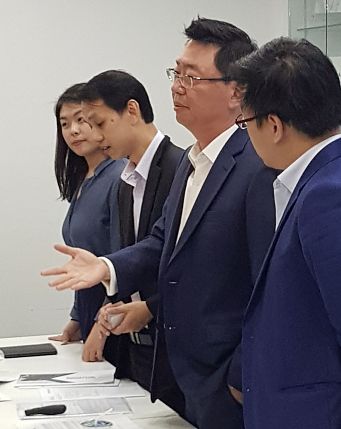A sharp downturn in the offshore and marine industry, triggered by the oil price collapse of 2014, took Singapore-listed Nam Cheong Ltd down but it appears to have emerged from the storm.
Nam Cheong has just announced RM80 million of long-term (ie more than one year) chartering contracts from Malaysian oil majors. The three vessels will be used to service works on floating LNG facilities and other production operations in Malaysian waters until 2022, with an optional extension period running until 2024. |
 L-R: Joy Leong (corporate finance) | Financial controller Chong Chung Fen | CEO Leong Seng Keat | Jonathan Leong, executive director of SKOSV Sdn Bhd, a Nam Cheong subsidiary.
L-R: Joy Leong (corporate finance) | Financial controller Chong Chung Fen | CEO Leong Seng Keat | Jonathan Leong, executive director of SKOSV Sdn Bhd, a Nam Cheong subsidiary.
NextInsight photo.Nam Cheong is one of Malaysia's largest OSV builders with its shipyard in Miri, Sarawak and partner shipyards in China.
The offshore & marine industry downturn dried up orders for new vessels, leading Nam Cheong to transform into a vessel owner and operator.
It charters out its fleet of 32 vessels, up from 20 in 1Q2018, mostly directly to oil majors such as ExxonMobil and Petronas.
The additional 12 vessels were all newly built.
Likewise, the first 20 were all built by Nam Cheong at its yard in Miri and subcontracted yards in the PRC.
"In the industry, we have one of the youngest fleets with average age of 3-4 years compared to an industry average of 8-10 years," said Nam Cheong's financial controller, Chong Chung Fen, at the 1Q19 results briefing.
Daily charter rates have improved significantly from 2H2018, and are expected to continue to firm up, said CEO Leong Seng Keat.
|
In 1Q19, as with 1Q18, all its revenue came from chartering and was derived from Malaysia.
|
||||||||||||||||||||||||||||
| Brightening industry outlook |
♦ The executive chairman, Tan Sri Datuk Tiong Su Kouk, subscribed for his rights entitlement, paying RM50 million. His resulting total stake in the company is 61.5%. ♦ The rights issue raised S$22 million in net proceeds. |
||||||||||||||||
In Malaysia, Petronas has planned capital expenditure of over RM50 billion for 2019, up from RM46.8 billion in 2018.
Of the total amount, RM30 billion will be allocated for upstream activities, a move that is expected to benefit local oil and gas service providers.
There is a tight supply of vessels, given the high cost of reactivating vessels that have been coldstacked and the still relatively low charter rates.
According to the Petronas Activity Outlook 2019-2021, a positive outlook is expected for anchor handling tug supply vessels (AHTS), platform supply vessels (PSV), as well as accommodation and maintenance vessels.
A pickup in drilling and development activities is also expected to bolster demand for AHTS and PSV.
The upturn is underpinning plans by Nam Cheong to repay its debt through growing chartering income, asset monetisation and diversifying income streams.
In the past two years, it successfully restructured its borrowings and trade payables. Notably:
|
♦ Borrowings stood at RM1.6 billion (short-term loans) as at end-2017 but it was down to RM1.0 billion (term loans) as at end 1Q19. |
Details of the restructuring and repayment schedule can be viewed in the company's AGM presentation slides here.







